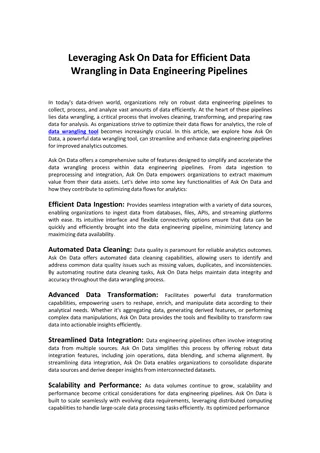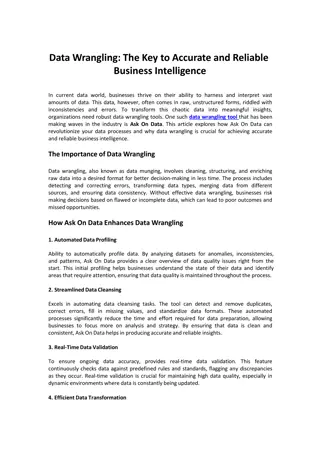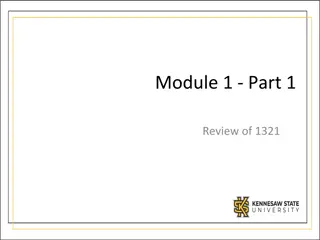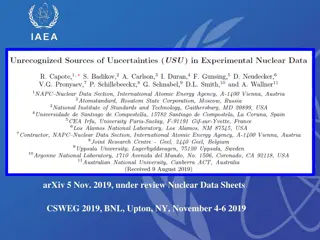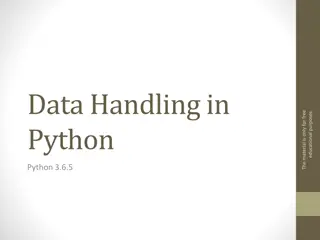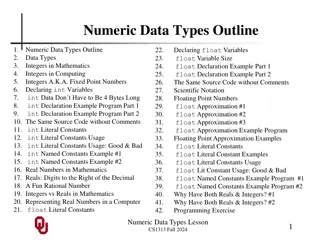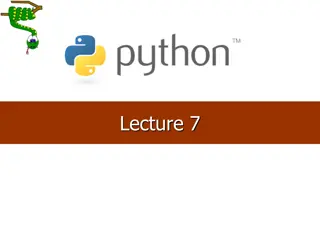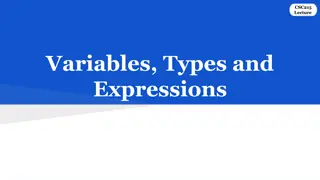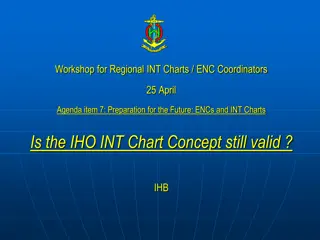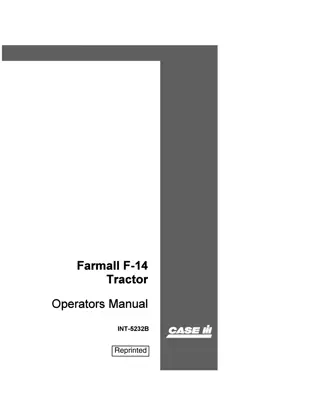
Reducing Uncertainties in Nuclear Data Evaluations
Learn about strategies for reducing uncertainties in nuclear data evaluations without using integral data. Discover how a Bayesian approach, extreme neutron spectra definition, and proposed solutions such as data adjustment can lead to lower uncertainties, with a new solution involving a toy model for universal anti-correlations. Explore key insights to improve accuracy and precision in nuclear data applications.
Download Presentation

Please find below an Image/Link to download the presentation.
The content on the website is provided AS IS for your information and personal use only. It may not be sold, licensed, or shared on other websites without obtaining consent from the author. If you encounter any issues during the download, it is possible that the publisher has removed the file from their server.
You are allowed to download the files provided on this website for personal or commercial use, subject to the condition that they are used lawfully. All files are the property of their respective owners.
The content on the website is provided AS IS for your information and personal use only. It may not be sold, licensed, or shared on other websites without obtaining consent from the author.
E N D
Presentation Transcript
Uncertainty reduction without using integral data Nuclear Data Section, International Atomic Energy Agency Department for Nuclear Sciences and Applications A. Trkov and R. Capote 1 IAEA NAPC-Nuclear Data Section, R. Capote & A. Trkov
Summary Issues in propagated ENDF/B-VIII.0 evaluation uncertainties for applications Basic knowledge of criticality and typical experimental (integral) uncertainties Bayesian approach leading to reduced uncertainties for applications Definition of extreme neutron spectra: thermal Maxwellian fast (taken as U-235 PFNS at the thermal) 14 MeV is possible, but can not benefit from this approach (not constrained by exp.) Possible applications and outlook 2 IAEA NAPC-Nuclear Data Section, R. Capote & A. Trkov
Well known: Evaluated uncertainties in general purpose libraries lead to large uncertainties for keff Fast assemblies ICSBEP, JENDL-4 (similar for ENDF/B-VIII.0) +1% 0 -1% See INDC(NDS)-0597, IAEA 2011, Fig. 4 by O. Iwamoto But keff(exp) ~ 0.2% ! Can we do something? 3 IAEA NAPC-Nuclear Data Section, R. Capote & A. Trkov
Proposed solutions: Data adjustment considering integral data (+ reaction rates + ) lead to adjusted library (GLSQ or TMC) (we know we need adjusted libraries for applications) Advantages: low uncertainties for applications Disadvantages: 1) Resulting biases due to compensation effects, if not all relevant quantities have uncertainties & cross- correlations defined in the adjustment input. The adjusted library is valid for selected benchmarks; however, due to biases, extrapolations generally fail => Repeated warnings by experienced evaluators to avoid contaminating evaluations with integral data (since the very beginning of evaluations) 4 IAEA NAPC-Nuclear Data Section, R. Capote & A. Trkov
A new solution to reduce uncertainties (1) Use additional knowledge to reduce the uncertainties 1)TOY MODEL: 1-group 0-D transport equation (Universally valid and independent of integral data ) ??? ??+ ??+ ??+ ? f=fission; c=capture; i=other, L=leakage ????= 2)Uncertainty of keffmeasurements (0.2-0.4%) Using 1) and 2)we can derive universal (anti) correlations (due to the constraint keff=0.2-0.4%) Derive those correlations for typical spectra: Maxwellian(<E>=0.0253eV), U-235 PFNS (<E>=2 MeV) Assume NO correlations between energy regions 5 IAEA NAPC-Nuclear Data Section, R. Capote & A. Trkov
A new solution to reduce uncertainties (2) Use additional knowledge about ALL critical systems Straightforward implementation in existing general- purpose libraries - Only (anti)correlations between ?,??,?? for 2-4 spectral groups need to be added (3N numbers, being N the number of energy groups) - We may also add uncertainty reduction for ? ? Typically we add ? ?? (anti) and/or ? ?? correlations No use of the integral data is made, universally valid within the given spectral region, safe extrapolation Significant reduction of the predicted uncertainty for integral quantities: keff~0.6-0.8% (in progress) Derived anti-correlations appear to be independent of the spectrum but short-range 6 IAEA NAPC-Nuclear Data Section, R. Capote & A. Trkov
DICE sensitivities: HST042.008 &HMF001 ?,?? ?????????,???? ????? ???????????? = ? HST042.008 (1 of Hardy set) HMF001 Godiva 0.00001 0.0001 0.01 0.10 1.0 10 100 1000 10000 10^5 10^6 10^7 7 IAEA NAPC-Nuclear Data Section, R. Capote & A. Trkov
A new solution to reduce uncertainties: Thermal Maxwellian spectrum (no integral data) dkeff unconstrained INPUT SAMPLED (.45%) f (1.2%) C (1.3%) Propag. keff = 861 pcm (smaller !!) C f L 2.425 (.45%) 587.3 (1.2%) 99.5 (1.3%) 2.425 100 f - 0.04 0.02 100 f 587.3 C L -0.06 100 C 99.5 0 0 0 100 C f dkeff = 400 pcm Small red. unc. L 2.425 (.39%) 587.3 (0.7%) 99.5 (1.3%) 100 f C L -82 100 f Strong in keff 5.9 14 100 C (-600 pcm) 0 0 0 100 8 IAEA NAPC-Nuclear Data Section, R. Capote & A. Trkov
A new solution to reduce uncertainties: Fast spectrum 235U(nth,f) PFNS (no integral data) dkeff unconstrained INPUT SAMPLED Propag. keff = 1100 pcm f 100 f C L 2.63 (.8%) 1.223 (1.2%) 0.094 (10%) 2.63 (.8%) 1.223 (1.2%) 0.094 (10%) -0.04 100 f f C L 0.02 -0.06 100 C C 0 0 0 100 C f dkeff = 200 pcm Small red. unc. L 100 2.63 (.6%) 1.223 (0.9%) 0.094 (9.7%) f -85 100 f Strong in keff C L 25 24 100 C (-1000 pcm) 0 0 0 100 9 IAEA NAPC-Nuclear Data Section, R. Capote & A. Trkov
Summary A new solution is proposed to reduce uncertainties in general-purpose libraries introducing Numerically similar to Rochmann et al (EPJ n 2017, 2018) and similar approaches but conceptually is very different. Approach based on the following assumptions: 1) 1-group 1D transport equation is valid to describe critical assemblies 2) Experimental keff=0.2-0.4% No integral data are used, assumptions applied are universally valid !! From these two assumptions, correlations are derived Straightforward implementation in existing general- purpose libraries (only (anti)correlations between ?,??,?? for selected spectral groups are added) Estimated significant reduction of the predicted uncertainty for integral quantities (in progress) 10 IAEA NAPC-Nuclear Data Section, R. Capote & A. Trkov


